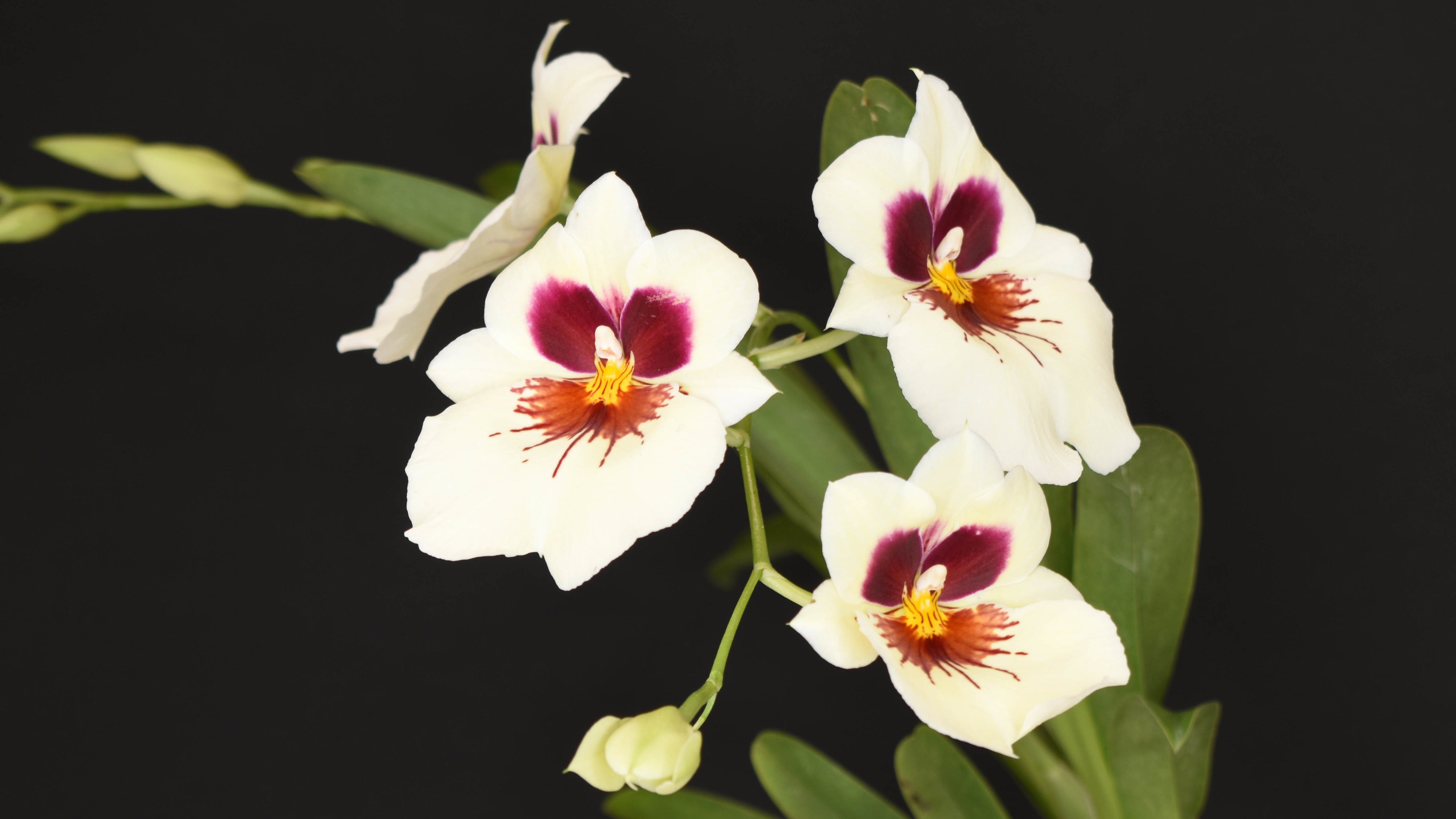
Miltonia / Miltoniopsis Orchid Complete Care Guide
You’re probably here because you just purchased a Miltonia or Miltoniopsis Orchid – congrats! Or perhaps, you’re teetering around the buy-now button, but you’re not sure if you’re cut out to be an orchid parent. We’ll help you figure that out. Hint: you are cut out for it.

Miltonia and Miltoniopsis are frequently lumped together, but originate from two different environments, giving them slightly different culture requirements. Miltoniopsis thrive in cooler weather (like in the Andes mountains of South America), while Miltonias prefer warmer temperatures (like southern Brazil). Simple enough right?
Before we get started, let’s clear one thing up. You may have heard both of these genera referred to as the pansy orchid. It’s because they look just like a garden pansy! How cute is that? It’s actually the Miltoniopsis orchids that really resemble pansies – Miltonia look a bit more like your garden variety Oncidium.
Okay, let’s take a look at the care plan for these cuties. They can be a bit finicky, but don’t panic yet – that’s why you have this guide, of course.
Light
We hate to say it, but these guys are very sensitive. If you have pale friends – like the type who must sit in the shade and reapply sunscreen every hour on the hour – then you already know what we’re talking about. Miltoniopsis can burn easily, especially in direct, hot, intense sunlight. Literally, their leaves can burn permanently. Not cute.
So, indirect light is a must. If you have a Miltonia, rather than a Miltoniopsis, you can get away with a little more light, since they like warmer environments, but still light shade to medium light should be your goal.
Along with light, you should keep an eye on temperature. For Miltoniopsis, you need to keep the temperature between 55 and 80°F, whereas Miltonia can handle temperatures over 90°F, as long as humidity is high (above 70%) and air keeps moving. If you don’t have air conditioning or heat in your home, then you’ll certainly need to pay close attention to the temperature in the summer and winter. For everyone else, if your home is climate-controlled, then you’re probably okay, since I’d take a wild guess and say most of us keep our homes between 55 and 80°F all year long. Fair assumption? If no, you’re wrong.
Water
Okay, moving right along – water. The pansy orchid needs a lot of water. Back home in South America, they’re soaked on practically a daily basis. You’ll need to recreate that while ensuring that they’re draining completely too. This doesn’t necessarily mean watering every day while using a maximum-porosity media. Adding some sphagnum moss to your mix helps with the required amount of moisture retention while still allowing room to breathe.
Fortunately, if they’re not getting enough water (or humidity), they’ll let you know. If the leaves start growing with creases – sort of like an accordion – you’re in trouble. You definitely need more water. If you do live in a more humid place (think New Orleans or Jacksonville), then you’ll probably have even better luck with these guys, since they thrive in those sticky, damp locales.
In general, you should be watering your Miltoniopsis so much that it should still be damp between watering. If you’re letting it dry out, you’re not doing it right. If it’s colder, you can water less (maybe even once a week), but you’ll have to increase this as the weather gets warmer.
We recommend putting your plant right in the sink and running warm water over the plant (avoiding the crown) until it’s running out of the bottom. Let it chill in the sink so it can completely drain before you put it back. Hey, you could even take it in the shower with you! The company might be weird, but it’ll certainly love the extra humidity. Just make sure you have enough room so you’re not sharing your shampoo. Your plant won’t love that. Your spouse might.
Miltonia are slightly more forgiving. They can handle, and even prefer, a little dryness inbetween water time.
If you’re still on the fence about hitting that buy button, think about where you live. If you’re always hot and sweaty, this might be the perfect plant for you. Even if you’re not always hot and sweaty, it’s the perfect plant for you. Who are you kidding??
Potting & Soil
Okay, if you haven’t realized by now, this isn’t exactly the lowest maintenance plant on earth, but it’s definitely not daunting. If you put in even the smallest bit of effort, we have a good feeling that your pansy orchid will survive and thrive.
Speaking of effort, you’re going to need to re-pot your plant after it flowers each year because they love to creep. Specifically, when new growth begins – it’s time to pot. At the very least, you may be able to get away with once every other year. But seriously, we’re sure you can find the time – once a year – to spend 10 minutes repotting your beloved orchid. Right? It’s not that tough.
As for the pot itself, Miltoniopsis does best in smaller, shallow pots, while Miltonias seem to do well mounted. In case you’re new to the whole orchid thing, mounting is basically recreating an orchid’s natural growing environment – orchids are epiphytes that grow on the sides of trees in the wild. It’s pretty easy to do! You’ll just need a mount (like cork, tree fern or wood) and something to secure the plant to the mount (say fishing line or string). Then, you’ll just need a place to hang it. Ideally, after a year, the plant will secure itself to the mount. We’ll dive deep into this subject in a later blog post, trust us!
Now, what to put inside the pot? Your best bet is loose, chopped sphagnum moss, about 30%, along with fir or pine bark mixed with aerators like pumice and charcoal. General orchid mix (for fine roots) will also work just fine. You’re basically just looking for a mix that drains well, but also holds water. An oxymoron? Yes. But, also very possible.
Fertilization
You’ll want to fertilize your plant in the same fashion as many other varieties – every week with a diluted (half-strength), balanced (10-10-10) fertilizer. If it’s overcast or the middle of winter, you can get away with fertilizing just once a month. Both Miltonia and Miltoniopsis are sensitive to salt and mineral buildup which can be caused by hard tap water or frequent fertilizing. It’s therefore vital that you flush your orchids roots with clean, unfertilized water about once a month.
Right before the plant blossoms – like in the early spring – you may also want to give it a punch with bloom booster – we recommend Dyna-Gro Bloom 3-12-6. Your plant will thank you later.
Propagation
Last but not least, let’s chat about propagation. How can you make your own baby orchids? Every plant owner’s dream!
It’s pretty easy, as long as you keep around four or five pseudobulbs per division. The trick is to use a sterilized utensil like a pair of precision garden snips to cut the rhizome just below the soil line. Make things easier for yourself by soaking the roots for a bit, and completely unpotting the plant before you get started. Be gentle!
You did it!
You don’t need to be a horticultural expert to raise a Milt variety orchid, but you certainly need to put in a little extra effort, compared to a succulent, for instance.
If you have a little extra room in your schedule (and heart), then we say – go for it. What’s the worst thing that could happen? You’re the kind of gardener that’s willing to put on your detective pants and troubleshoot your plant problems! Whether it’s experimenting with your potting mix, fertilizer schedule, or lighting – we’ve got faith in your plant-raising skills.
So, go grab yourself a Miltoniopsis or Miltonia. We’re always here to help along the way. Just keep this guide close by. Print it, hang it on your fridge, save it to your phone’s photo album – whatever it takes, just keep it nearby. You’re well on your way to being a great orchid mom or dad.

We love orchids.
We love caring for them, we love learning about them.
Miltonia and Miltoniopsis are becoming increasingly popular among collectors. While we don’t always have them in stock – we usually do! Check out the store if you’re interested.
Get in touch with us!
Accepted Payments:

Leave a comment: